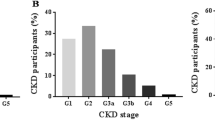Summary
Evaluating the prevalence of kidney damage according to population-based studies in different communities has been limited in developing countries. We conducted a population-based screening study in Uygur people of Urumqi, aiming to identify the prevalence and associated risk factors of chronic kidney disease (CKD) in Uygur populations. A total of 2576 residents (>18 years) from four districts of Urumqi were interviewed from June 2007 to January 2009 and tested for haematuria, albuminuria and reduced renal function. Associations between age, gender, smoking, diabetes mellitus, hypertension, hyperuricaemia and kidney damage were examined. There were 2576 subjects enrolled in this study. After age correction, the prevalence of albuminuria, haematuria and reduced estimated glomerular filtration rate (eGFR) was 3.58%, 2.26% and 1.03%, respectively. Approximately 5.65% of the sample population had at least one indicator of kidney damage. Age, diabetes mellitus, hypercholesteremia, hyperuricaemia and hyperlipidaemia were independently associated with CKD. In the general Uygur adult population from Urumqi, 5.65% had either proteinuria, haematuria or reduced eGFR, indicating the presence of kidney damage, with an awareness of only 1.05%. The high prevalence and low awareness of CKD in this population suggest an urgent need for CKD prevention programs in Uygur people.
Similar content being viewed by others
References
Chadban SJ, Brigand EM, Kerr PG, et al. Prevalence of kidney damage in Australian adults: the AusDiab kidney study. J Am Soc Nephrol, 2003,14(7 Suppl 2): 131–S138
Coresh J, Astor BC, Greene T, et al. Prevalence of chronic kidney disease and decreased kidney function in the adult US population: Third National Health and Nutrition Examination Survey. Am J Kidney Dis, 2003, 1(1):1–12
Hallan SI, Coresh J, Astor BC, et al. International comparison of the relationship of chronic kidney disease prevalence and ESRD risk. J Am Soc Nephrol 2006,17(8):2275–2284
van Dijk PC, Jager KJ, de Charro F, et al. Renal replacement therapy in Europe: the results of a collaborative effort by the ERA-EDTA registry and six national or regional registries. Nephrol Dial Transplant, 2001,16(6):1120–1129
Xue JL, Ma JZ, Louis TA, et al. Forecast of the number of patients with end-stage renal disease in the United States to the year 2010. J Am Soc Nephrol, 2001,12(12): 2753–2758
Levey AS, Eckardt KU, Tsukamoto Y, et al. Definition and classificatioan of chronic kidney disease: a position statement from Kidney Disease: Improving Global Outcomes (KDIGO). Kidney Int, 2005,67(6):2089–100
Lord GM, Tagore R, Cook T, et al. Nephropathy caused by Chinese herbs in the UK. Lancet 1999,354(9177): 81–482
Ma YC, Zuo L, Chen JH, et al. Modified glomerular filtration rate estimating equation for Chinese patients with chronic kidney disease. J Am Soc Nephrol, 2006, 7(10):2937–2944
National Kidney Foundation: K/DOQI Clinical Practice Guidelines for Chronic Kidney Disease: Evaluation, classification, and stratification. Am J Kidney Dis, 2002,39(2 Suppl 1):S1–S266
Zhang L, Zhang P, Wang F, et al. Prevalence and factors associated with CKD: a population study from Beijing. Am J Kidney Dis, 2008,51(3):373–384
Clase CM, Kiberd BA, Garg AX, et al. Relationship between glomerular filtration rate and the prevalence of metabolic abnormalities: results from the Third National Health and Nutrition Examination Survey (NHANES III). Nehron Clin Pract, 2007,105(4):c178–184
Zhang L, Zuo L, Xu G, et al. Community-based screening for chronic kidney disease among populations older than 40 years in Beijing. Nephrol Dial Transplant 2007,22(4):1093–109
Chen J, Wildman RP, Gu D, et al. Prevalence of decreased kidney function in Chinese adults aged 35 to 74 years. Kidney Int, 2005,68(6):2837–2845
Li PK, Kwan BC, Leung CB, et al. Prevalence of silent kidney disease in Hong Kong: The screening for Hong Kong Asymptomatic Renal Population and Evaluation (SHARE) program. Kidney Int Suppl, 2005,(94): S36–S40
Shen P, He L, Li Y, et al. Natural history and proenostic factors of IgA nephropathy presented with isotated microscoptc hematuria in Chinese patients. Nephron Clin Pract, 2007,106(4):c157–c161
Koyama A, Igarashi M, Kobayashi M: Natural history and risk factors for immunoglobulin A nephropathy. Am J Kidney Dis, 1997,29(4):526–532.
Chow KM, Kwan BC, Li PK, et al. Asymptomatic isolated microscopic haematuria: long-term follow-up. QJM, 2004,97(11):739–745
Yamagata K, Takahashi H, Tomida C, et al. Proenosis of asymptomatic hematuria and/or proteinuria in men. High prevalence of IgA nephropathy among proteinuric patients found in mass screening. Nephron, 2002, 91(1):34–42
Sytjanen J, Mustonen J, Pasternack A, et al. Hyper-triglyceridaemia and hyperuricaemia are risk factors for progression of IgA nephropathy. Nephrol Dial Transplant, 2000,15(1):34–42
Iseki K, Oshiro S, Tozawa M, et al. Significance of hyperuricemia on the early detection of renal failure in a cohort of screened subjects. Hypertens Res, 2001, 24(6): 691–697
Kanellis J, Feig DI, Johnson RJ, et al. Does asymptomatic hyperuricaemia contribute to the development of renal and cardiovascular disease? An old controversy renewed. Nephrology (Carlton), 2004,9(6):394–399
Siu YP, Leung KT, Tong MK, et al. Use of allopurinol in slowing the progression of renal disease through its ability to lower serum uric acid level. Am J Kidney Dis 2006,47(1):51–59
Prevalence of chronic kidney disease and associated risk factors-United States, 1999–2004. MMWR Morb Mortal Wkly Rep, 2007,56(8):161–165
Author information
Authors and Affiliations
Corresponding authors
Additional information
This project was supported by grants from Scientific and Technologic Committee of Urumqi, China (No. Y06231006), and from frontier supporting science and technology projects of Xinjiang Uygur Autonomous Region, China (No. 200840102-38).
Rights and permissions
About this article
Cite this article
Lu, C., Zhao, H., Xu, G. et al. Prevalence and risk factors associated with chronic kidney disease in a Uygur adult population from Urumqi. J. Huazhong Univ. Sci. Technol. [Med. Sci.] 30, 604–610 (2010). https://doi.org/10.1007/s11596-010-0550-1
Received:
Published:
Issue Date:
DOI: https://doi.org/10.1007/s11596-010-0550-1




